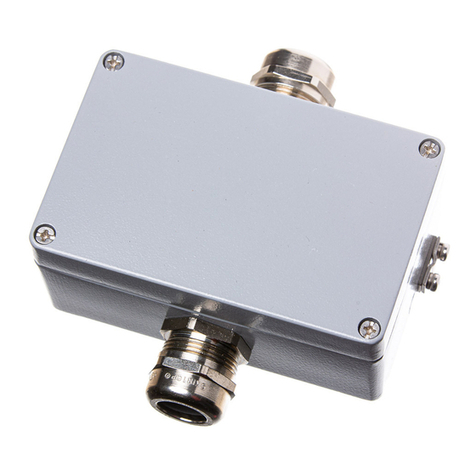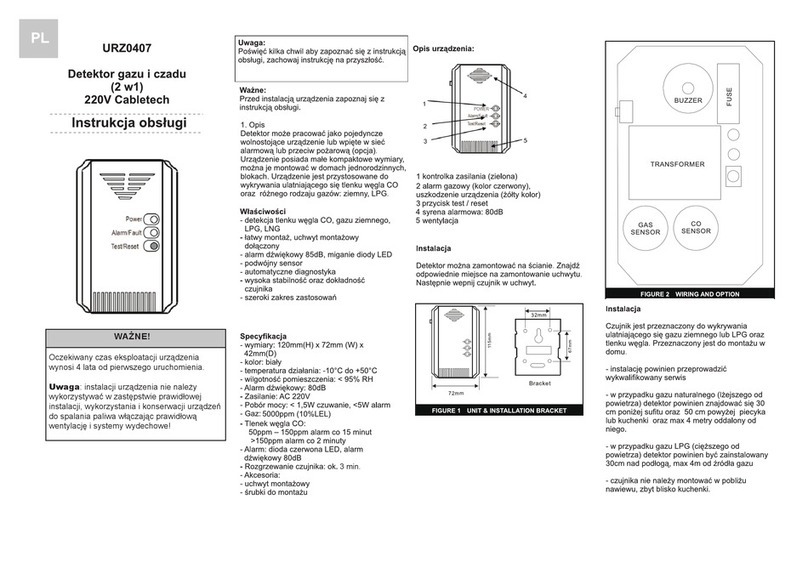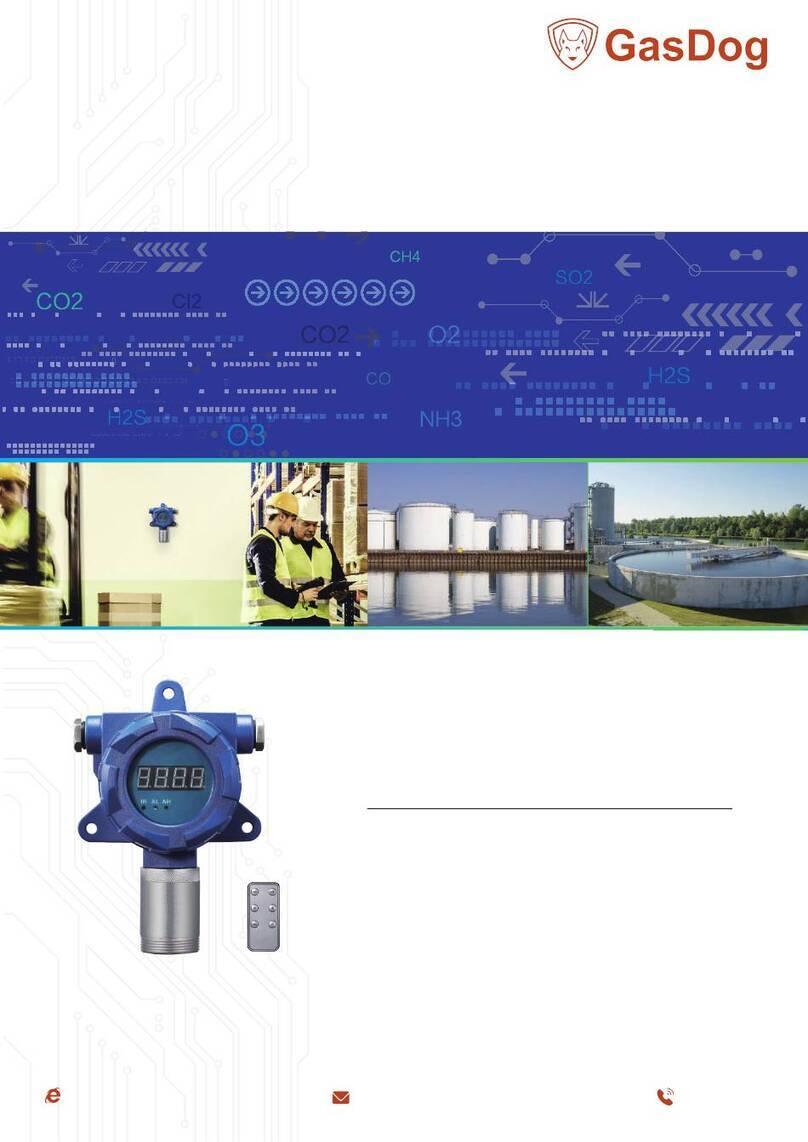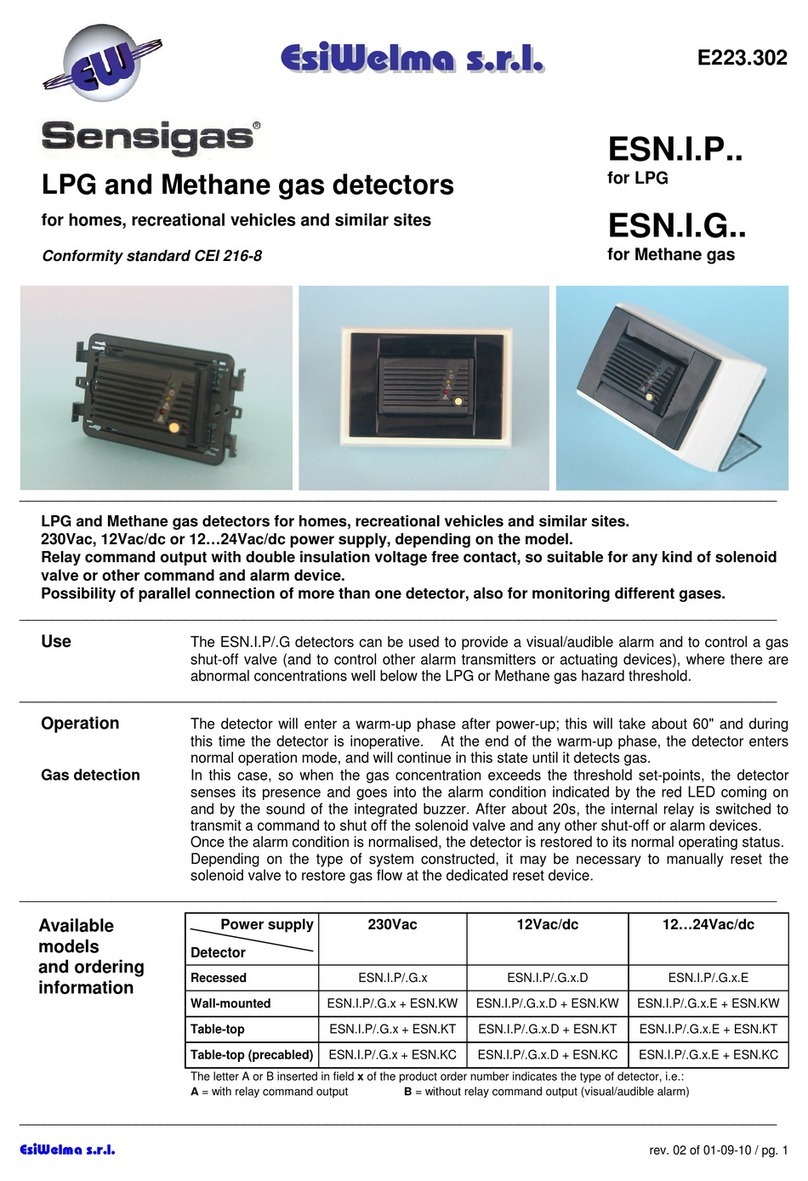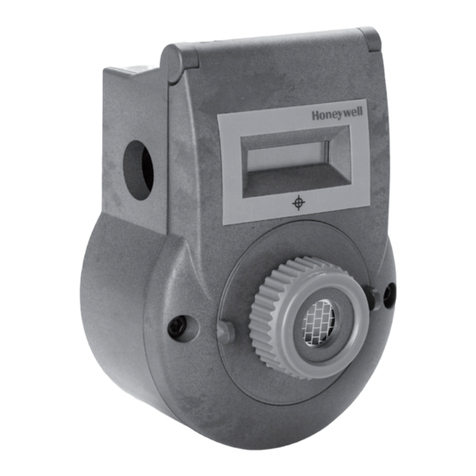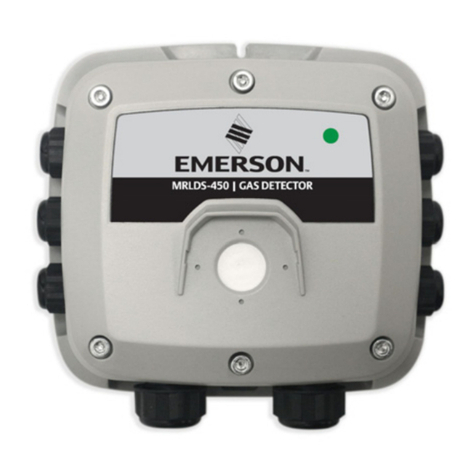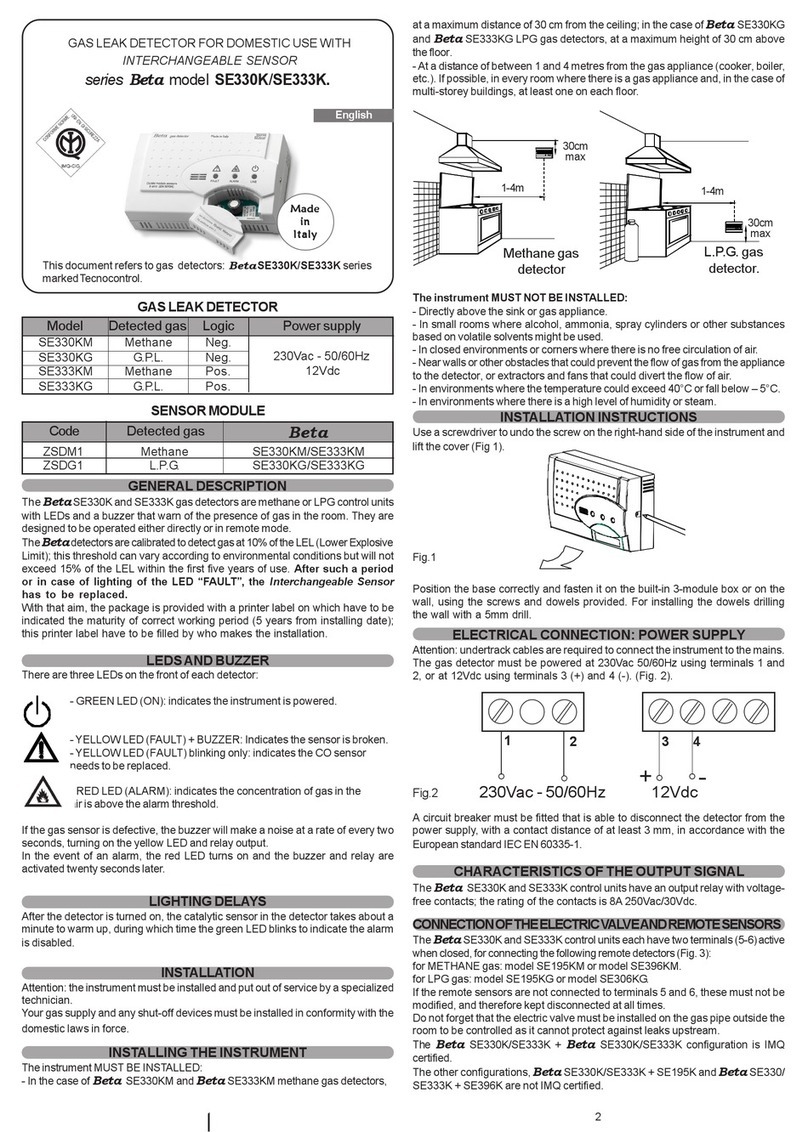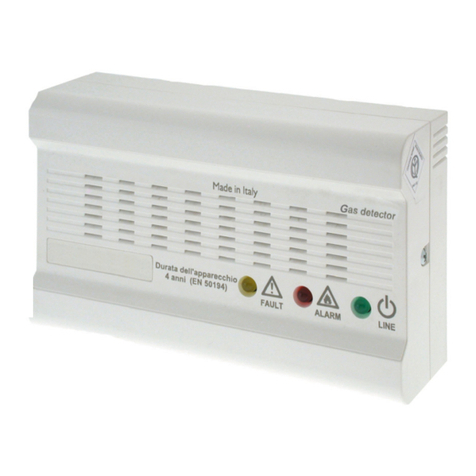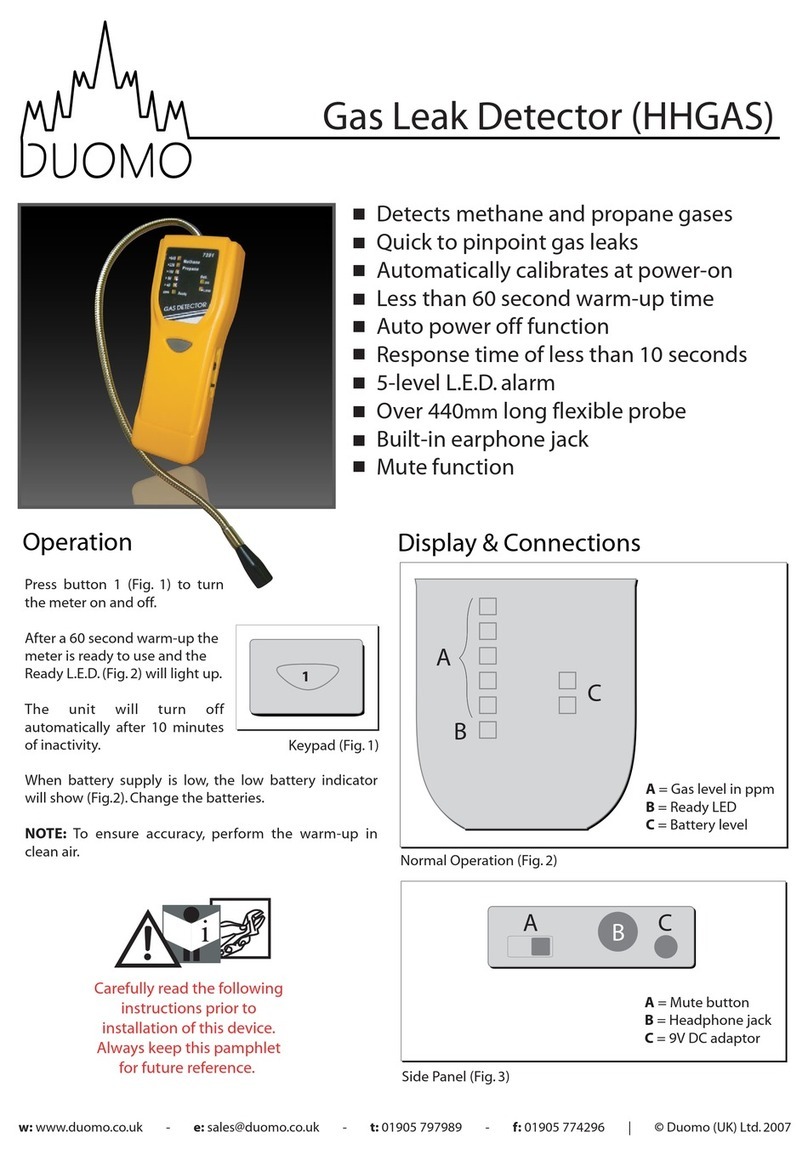Orno OR-DC-614 Manual

OR-DC-614
Czujnik gazu ziemnego
Natural gas detector
Erdgas-Sensor
ORNO-LOGISTIC Sp. z o.o.
ul. Rolników 437
44-141 Gliwice
tel. 32 43 43 110
(PL) WAŻNE!
Przed rozpoczęciem korzystania z urządzenia, należy zapoznać się z niniejszą instrukcją obsługi oraz zachować ją na przyszłość. Dokonanie samodzielnych napraw i modyfikacji skutkuje utratą
gwarancji. Producent nie odpowiada za uszkodzenia mogące wyniknąć z nieprawidłowego montażu czy eksploatacji urządzenia.
Z uwagi na fakt, że dane techniczne podlegają ciągłym modyfikacjom, Producent zastrzega sobie prawo do dokonywania zmian dotyczących charakterystyki wyrobu oraz wprowadzania innych
rozwiązań konstrukcyjnych niepogarszających parametrów i walorów użytkowych produktu.
Dodatkowe informacje na temat produktów marki ORNO dostępne są na: www.orno.pl. Orno-Logistic Sp. z o.o. nie ponosi odpowiedzialności za skutki wynikające
z nieprzestrzegania zaleceń niniejszej instrukcji. Firma Orno-Logistic Sp. z o.o. zastrzega sobie prawo do wprowadzania zmian w instrukcji - aktualna wersja do pobrania ze strony www.orno.pl.
Wszelkie prawa do tłumaczenia/interpretowania oraz prawa autorskie niniejszej instrukcji są zastrzeżone.
1. Nie używaj urządzenia niezgodnie z jego przeznaczeniem.
2. Nie zanurzaj urządzenia w wodzie i innych płynach.
3. Nie obsługuj urządzenia gdy uszkodzona jest obudowa.
4. Nie otwieraj urządzenia i nie dokonuj samodzielnych napraw.
5. Magazynuj urządzenie w suchym i ciemnym miejscu, a w czasie transportu nie rzucaj opakowaniem i nie narażaj na uszkodzenia mechaniczne.
6. Urządzenie jest przeznaczone do użytku wewnętrznego.
(EN) IMPORTANT!
Before using the device, read this Service Manual and keep it for future use. Any repair or modification carried out by yourselves results in loss of guarantee. The manufacturer is not responsible
for any damage that can result from improper device installation or operation.
In view of the fact that the technical data are subject to continuous modifications, the manufacturer reserves a right to make changes to the product characteristics and to introduce different
constructional solutions without deterioration of the product parameters or functional quality.
Additional information about ORNO products are available at www.orno.pl. Orno-Logistic Sp. z o.o. holds no responsibility for the results of non-compliance with the provisions of the present
Manual. Orno Logistic Sp. z o.o. reserves the right to make changes to the Manual - the latest version of the Manual can be downloaded from www.orno.pl. Any translation/interpretation rights
and copyright in relation to this Manual are reserved.
1. Do not use the device contrary to its dedication.
2. Do not immerse the device in water or other fluids.
3. Do not operate the device when its housing is damaged.
4. Do not open the device and do not repair it by yourselves.
5. Store the unit in a dry and dark place, and do not throw packaging and do not expose it to mechanical damage during transportation.
6. Suitable for indoor use only.
(DE) WICHTIG!
Bevor Sie das Gerät in Betrieb nehmen, lesen Sie bitte diese Bedienungsanleitung und bewahren Sie sie zum späteren Nachschlagen auf. Eigene Reparaturen und Modifikationen führen zum
Verlust der Garantie. Der Hersteller haftet nicht für Schäden, die durch unsachgemäße Montage oder Bedienung des Gerätes entstehen können.
Da die technischen Daten ständigen Änderungen unterliegen, behält sich der Hersteller das Recht vor, Änderungen an den Produkteigenschaften vorzunehmen und andere konstruktive Lösungen
einzuführen, die die Parameter und funktionellen Eigenschaften des Produkts nicht beeinträchtigen.
Für weitere Informationen zu ORNO-Produkten besuchen Sie bitte die Website: www.orno.pl. Orno-Logistic Sp. z o.o. haftet nicht für die Folgen der Nichtbeachtung der Anweisungen in dieser
Bedienungsanleitung. Firma Orno-Logistic Sp. z o.o. behält sich das Recht vor, Änderungen in der Bedienungsanleitung vorzunehmen - aktuelle Version zum Herunterladen unter www.orno.pl.
Alle Rechte an Übersetzung/Dolmetschen und Urheberrechten an dieser Bedienungsanleitung sind vorbehalten.
1. Verwenden Sie die Einrichtung nur ordnungsgemäß.
2. Tauchen Sie die Einrichtung niemals in Wasser oder anderen Flüssigkeiten.
3. Bedienen Sie die Einrichtung nicht, wenn das Gehäuse beschädigt ist.
4. Öffnen Sie die Einrichtung nicht und führen Sie keine selbstständigen Reparaturen aus.
5. Bewahren Sie das Gerät an einem trockenen und dunklen Ort auf, werfen Sie die Verpackung nicht weg und setzen Sie es während des Transports keinen mechanischen
Beschädigungen aus.
6. Das Produkt ist für den Einsatz Innenbereich bestimmt.
Każde gospodarstwo jest użytkownikiem sprzętu elektrycznego i elektronicznego, a co za tym idzie potencjalnym wytwórcą niebezpiecznego dla ludzi i środowiska odpadu, z tytułu obecności w sprzęcie
niebezpiecznych substancji, mieszanin oraz części składowych. Z drugiej strony zużyty sprzęt to cenny materiał, z którego możemy odzyskać surowce takie jak miedź, cyna, szkło, żelazo i inne. Symbol
przekreślonego kosza na śmieci umieszczany na sprzęcie, opakowaniu lub dokumentach do niego dołączonych wskazuje na konieczność selektywnego zbierania zużytego sprzętu elektrycznego i elektronicznego.
Wyrobów tak oznaczonych, pod kara grzywny, nie można wyrzucać do zwykłych śmieci razem z innymi odpadami. Oznakowanie oznacza jednocześnie, że sprzęt został wprowadzony do obrotu po dniu 13 sierpnia
2005r. Obowiązkiem użytkownika jest przekazanie zużytego sprzętu do wyznaczonego punktu zbiórki w celu właściwego jego przetworzenia. Zużyty sprzęt może zostać również oddany do sprzedawcy,
w przypadku zakupu nowego wyrobu w ilości nie większej niż nowy kupowany sprzęt tego samego rodzaju. Informacje o dostępnym systemie zbierania zużytego sprzętu elektrycznego można znaleźć w punkcie
informacyjnym sklepu oraz w urzędzie miasta/gminy. Odpowiednie postępowanie ze zużytym sprzętem zapobiega negatywnym konsekwencjom dla środowiska naturalnego i ludzkiego zdrowia!
Each household is a user of electrical and electronic equipment, and hence a potential producer of hazardous waste for humans and the environment, due to the presence of hazardous substances, mixtures and
components in the equipment. Onthe other hand, usedequipment is valuable material from whichwe can recover raw materials such as copper, tin, glass, iron and others. The weee sign placed on the equipment,
packaging or documents attached to it indicates the need for selective collection of waste electrical and electronic equipment. Products so marked, under penalty of fine, cannot be thrown into ordinary garbage
along with other waste. The marking means at the same time that the equipment was placed on the market after August 13, 2005. It is the responsibility of the user to hand the used equipment to a designated
collection point for proper processing. Used equipment can also be handed over to the seller, if one buys a new product in an amount not greater than the new purchased equipment of the same type. Information
on the available collection system of waste electrical equipment can be found in the information desk of the store and in the municipal office or district office. Proper handling of used equipment prevents negative
consequences for the environment and human health!
Jeder Haushalt ist ein Nutzer von elektrischen und elektronischen Geräten und dadurch auch ein potenzieller Produzent von für Menschen und Umwelt gefährlichen Abfällen aufgrund der sich drin befindenden
gefährlichen Stoffe, Mischungen und Bestandteile. Andererseits sind die gebrauchten Geräte auch ein wertvoller Stoff, aus denen wir Rohstoffe wie:Kupfer, Zinn, Glas, Eisen und andere wieder verwerten können.
Das Zeichen einer durchgestrichenen Mülltonne auf dem Gerät, der Verpackung oder in den Dokumenten, die dem Gerät beigelegt sind, weist darauf hin, dass die elektronischen und elektrischen Altgeräte
getrennt gesammelt werden müssen. Die so gekennzeichneten Produkte dürfen nicht im normalen Hausmüll mitsamt anderen Abfällen entsorgt werden, unter Androhung einer Geldbuße. Das Zeichen bedeutet
auch, dass das Gerät nach dem 13. August 2005 in den Verkehr gebracht wurde. Der Nutzer ist verpflichtet, das Altgerät an die angewiesene Rücknahmestelle zu übermitteln, damit es richtig wieder verwertet
wird. Beim Kauf von neuen Geräten kann man die Altgeräte in gleicher Menge und Art beim Verkäufer zurückgeben. Die Informationen über das System der Sammlung der elektrischen Altgeräte kann man sich
bei einem Auskunftspunkt des Ladens sowie bei der Stadt-/Gemeindeverwaltung einholen. Der richtige Umgang mit den Altgeräten verhindert negative Konsequenzen für die Umwelt und die Gesundheit!
02/2020
(PL) Instrukcja obsługi i montażu
Gaz ziemny jest gazem bezbarwnym o słabym zapachu i jest lżejszy od powietrza, gromadzi się w górnych partiach pomieszczeń.
W połączeniu z tlenem w powietrzu tworzy mieszaninę palną i wybuchową. Największe zagrożenie występuje podczas nieszczelności
np. kuchenki gazowej. Zapłon może nastąpić od urządzeń znajdujących się powyżej jak np. włącznik światła.
Przyczyny wycieku gazu:
•Niewłaściwy zapłon.
•Zgaszenie płomienia gazu podczas gotowania wywołane podmuchem wiatru.
•Zgaszenie płomienia gazu podczas gotowania wywołane zmianą ciśnienia gazu.
•Zawór gazowy nie został dokładnie zamknięty.

2
•Niewłaściwe wykorzystanie narzędzi kuchennych.
•Uszkodzenie węża doprowadzającego gaz.
•Inne przyczyny.
CHARAKTERYSTYKA
FUNKCJE
Czujnik OR-DC-614 jest nowoczesnym detektorem gazu
ziemnego do zastosowania wewnątrz pomieszczeń. Służy
do ciągłego monitoringu obecności i wykrywania gazu
ziemnego wydostającego się z nieszczelności. W
urządzeniu zastosowano wysokiej jakości czujnik
półprzewodnikowy pozwalający na osiągnięcie wysokiego
wskaźnika wykrywalności. Po wykryciu wycieku gazu
osiągającego ustawiony próg alarmowy detektor wyda
sygnał dźwiękowy oraz włączy się czerwona dioda LED.
Czujnik OR-DC-614 posiada:
−wysokiej jakości czujnik półprzewodnikowy
−powiadomienie optyczne i dźwiękowe,
−przycisk TEST, który pozwala sprawdzić poprawność
działania czujnika,
−sygnalizację za pomocą diod (czerwona, żółta),
−dodatkowe wyjście przekaźnikowe umożliwiające
przekazanie impulsu do innego urządzenia przy
przekroczonym stężeni alarmowym (np. wentylator,
syrena alarmowa, dialer telefoniczny,
elektromagnetyczny zawór gazu)
−funkcja zamykania zaworu odcinającego dopływ gazu
do instalacji
SPECYFIKACJA TECHNICZNA
Zasilanie:
AC230V, 50Hz
Pobór mocy:
≤3W
Temperatura:
00C~550C
Wilgotność:
<95%
Rodzaj sensora:
półprzewodnikowy
Czułość i czas działania :
10% LEL*
błąd: ±3% LEL
Poziom głośności:
≥70dB
Wymiary:
85 x 125 x 45 mm (szer./wys./gł.)
Waga netto:
290 g
*LEL jest dolną granicą wybuchowości. Stanowi ona najniższe stężenie gazu w powietrzu, przy którym następuje wybuch w kontakcie z otwartym
płomieniem.
BUDOWA URZĄDZENIA
1. Dioda zielona –ZASILANIE
2. Dioda żółta – W-UP –podgrzewanie sensora
3. Dioda żółta – BŁĄD
4. Otwory wentylacyjne
5. Przycisk W-UP –podgrzewanie sensora (naciśnij aby
wyłączyć podgrzewanie sensora i przejść w stan pracy)
6. Przycisk TEST
7. ALARM
8. Sygnał wyjściowy zaworu +
9. Sygnał wyjściowy zaworu -
10. NC
11. COM
12. NO
13. AC230V
14. AC230V
3A, 250V AC
3A, 30V DC
12VDC
150mA

3
INSTALACJA URZĄDZENIA
Czujnik powinien być zainstalowany w pomieszczeniach, w których zamontowane urządzenia mogą być źródłem
zagrożenia. Nie wyklucza to także zasadności montażu dodatkowych czujników np. w korytarzach, sypialniach itp.
Wybierając miejsce instalacji urządzenia należy upewnić się, czy alarm dźwiękowy będzie dobrze słyszalny z innych
pomieszczeń. Zaleca się montaż detektora na każdym piętrze domu wielokondygnacyjnego.
1. Zamocuj urządzenie na ścianie w odległości 2~4m zmierzonej w poziomie od kuchenki gazowej lub źródła emisji gazu
ziemnego.
2. W pionie na wysokości 0,3 metra od sufitu.
Montaż urządzenia:
1. Wybierz odpowiednią ścianę lub miejsce zgodnie z powyższymi zaleceniami.
2. Zamocuj ramkę montażową za pomocą śruby M5 lub M3 (wg powyższego rysunku, dwa opcjonalne rodzaje 5 i 3),
a następnie przymocuj do niej urządzenie.
UWAGA:
Miejsca, w których nie należy instalować detektora:
−w bliskiej odległości od okien, drzwi czy przewodów wentylacyjnych lub przejść narażonych na silne podmuchy wiatru,
−w miejscach o dużej wilgotności, zakurzeniu,
−w pomieszczeniach o dużym zapyleniu i zadymieniu,
−w miejscach narażonych na wysokie temperatury w wyniku działania pieców,
−w miejscach, gdzie urządzenie byłoby zakryte innymi elementami (za meblami lub zasłonami).
UWAGA:
Detektor sygnalizuje zagrożenie dopiero po jego zamontowaniu.
OBSŁUGA URZĄDZENIA
1. Podłącz urządzenie do sieci ~230V/50Hz.
2. Jeżeli do przekaźnika chcesz podłączyć wentylator, zawór elektromagnetyczny itp. wykonaj to w pierwszej kolejności.
3. Po podłączeniu zaświeci się zielona dioda ZASILANIE oraz żółta dioda W-UP –podgrzanie sensora. Czujnik przez kolejne 3
minuty pozostanie w stanie braku gotowości do użytkowania. W tym czasie sensor będzie się nagrzewał. Po całkowitym nagrzaniu
się sensora żółta dioda W-UP zgaśnie, a urządzenie przejdzie w stan gotowości do użytkowania.

4
4. W przypadku, gdy stężenie gazu w otoczeniu zrówna się lub przekroczy zaprogramowany poziom, urządzenie przejdzie w stan
alarmowy. Zaświeci się wówczas czerwona dioda ALARM oraz wyemitowany zostanie sygnał dźwiękowy. W tym samym czasie,
sygnalizacja alarmowa wywoła aktywację przekaźnika lub zaworu.
5. Po zmniejszeniu stężenia gazu w otoczeniu poniżej zaprogramowanego poziomu, sygnalizacja alarmowa wykrywacza zostanie
automatycznie wyłączona wraz z opcjonalnie podłączonymi urządzeniami. Czujnik ponownie przejdzie w stan roboczy.
6. Jeśli na czujniku zaświeci się żółta dioda BŁĄD oznacza to, że urządzenie nie działa prawidłowo lub jest uszkodzone. W takich
przypadkach prosimy o kontakt z dostawcą.
UWAGA: Podczas przygotowania urządzenia do pracy (rozruchu) nie naciskaj przycisku TEST.
Przycisk TEST służy do testowania, sprawdzania poprawności działania urządzenia.
TEST URZĄDZENIA - Testuj urządzenie regularnie 1 raz w tygodniu.
1. Częste testy urządzenia są wymagane aby sprawdzić, czy zasilanie alarmu jest prawidłowe oraz czy alarm działa poprawnie.
2. Naciśnij przycisk TEST.
3. Urządzenie wyda sygnał dźwiękowy.
4. Podczas testowania urządzenia sprawdź czy dźwięk jest dobrze słyszalny we wszystkich pomieszczeniach.
5. Nigdy nie używaj otwartego ognia w celu testowania urządzenia.
6. Nigdy nie przykładaj urządzenia do uszu podczas detekcji lub testowania, gdyż może to spowodować uszkodzenie słuchu.
JAK POSTĘPOWAĆ W CHWILI ALARMU!
Jeżeli w powietrzu zostanie przekroczone dopuszczalne stężenie gazu w urządzeniu uruchomi się sygnał dźwiękowy
i zacznie migać czerwona dioda ALARM!
(1) Opuść pomieszczenie, w którym zostało wykryte zagrożenie.
(2) Natychmiast odetnij zasilanie główne i zamknij kurki odcinające dopływ gazu do instalacji i urządzeń.
(3) Otwórz drzwi i okna w pomieszczeniu w celu wywołania „przeciągu”. Pozostawienie otwartych okien i drzwi może
spowodować, że nagromadzony gaz zostanie rozproszony przed nadejściem pomocy i alarm przestanie emitować sygnał
dźwiękowy. Chociaż problem mógł zostać tymczasowo rozwiązany, niezwykle istotne jest zlokalizowanie źródła
zagrożenia.
(4) Wyłącz urządzenia będące źródłem gazu ziemnego.
(5) Nie wolno włączać i wyłączać światła i innych urządzeń elektrycznych (możliwość powstania iskry), w tym telefonów
komórkowych!
(6) Jeżeli ktokolwiek odczuwa objawy zatrucia (nudności, bóle głowy) należy niezwłocznie skontaktować się
z pogotowiem ratunkowym
(7) Sprawdź przyczynę wycieku gazu. Funkcja odcinania dopływu gazu emituje co 10 sekund pulsujący sygnał.
(8) Skonsultuj sytuację z odpowiednio wyszkolonymi służbami (np. Straż Pożarna tel. 998, Pogotowie Gazowe tel. 992).
(9) Jeżeli alarm jest fałszywy sprawdź czy miejsce instalacji urządzenia jest prawidłowe.
UWAGI I ŚRODKI OSTROŻNOŚCI
1. Regularnie testuj urządzenie 1 raz w tygodniu przyciskiem TEST.
2. W celu prawidłowej pracy urządzenie musi być podłączone do sieci przez okres 24 godzin.
3. Czyść regularnie urządzenie z pyłu i kurzu za pomocą odkurzacza, a zwłaszcza wlot powietrza i panel z diodami
informacyjnymi. Przed odkurzaniem odłącz zasilanie.
4. Nie rozpylaj środków czyszczących bezpośrednio na obudowę urządzenia.
5. Nie dopuść, aby do wnętrza obudowy dostała się woda.
6. Nie pokrywaj urządzenia farbą.
7. Nie używaj do czyszczenia detergentów oraz środków na bazie rozpuszczalników. Substancje chemiczne mogą prowadzić do
trwałego uszkodzenia urządzenia.
8. Możliwe jest zaburzenie działania alarmu pod wpływem długotrwałego narażenia urządzenia na działanie dymu papierosowego,
oparów alkoholu, perfum, benzyny, farb i lakierów oraz innych organicznych wyziewów.

5
9. Nie używaj ani nie przechowuj urządzenia w miejscu narażonym na wzajemnie znoszące się gazy.
10. Prosimy nie użytkować i nie przechowywać czujników w środowisku gazów korozyjnych (takich jak Cl2).
11. Nie otwieraj obudowy urządzenia i nie dokonuj napraw lub jakichkolwiek modyfikacji we własnym zakresie.
12. Nie pozwalaj dzieciom bawić się urządzeniem.
13. Czujnik nie zastępuje czujnika dymu lub detektora gazów palnych (innych niż gaz ziemny).
WYKRYWANIE I ROZWIĄZYWANIE PROBLEMÓW
Nie świeci zielona dioda ZASILANIE
Brak podłączenia do zasilania
Sprawdź podłączenie do sieci
Uszkodzona dioda
Skontaktuj się z dostawcą lub serwisem
Po wciśnięciu przycisku TEST
sygnalizacja dźwiękowa nie włącza się
Uszkodzenie elektroniki
Skontaktuj się z dostawcą lub serwisem
Urządzenie nie wykrywa stężenia gazu
Uszkodzenie elektroniki
Skontaktuj się z dostawcą lub serwisem
Nie zakończone podgrzewanie
sensora
Zaczekaj do zakończenia procesu
podgrzewania sensora
Urządzenie uruchamia alarm po
zakończeniu podgrzania sensora
Zbyt duże stężenie dymu, alkoholu
lub perfum albo innych substancji
lotnych w powietrzu.
Przewietrz pomieszczenie i wykonaj
ponowny test urządzenia
Urządzenie przechowywane zbyt
długo w magazynie
Rozgrzewaj urządzenie przez ponad 2
godziny
Uszkodzenie elektroniki
Skontaktuj się z dostawcą lub serwisem
Sygnalizatory obecności gazów palnych ze względu na uwarunkowania techniczne (np. możliwość okresowych zaników napięcia,
awaria urządzenia itp.) oraz specyfikę pomieszczeń, w których urządzenia te mogą być montowane, nie dają całkowitej pewności
wykrycia niebezpiecznych gazów, a jedynie znacznie podnoszą prawdopodobieństwo wcześniejszego wykrycia jego
niebezpiecznego stężenia. Stąd należy pamiętać, iż urządzenia te należy testować zgodnie z załączoną instrukcja obsługi oraz
dokonywać okresowych przeglądów stanu instalacji wentylacyjnych i kominowych oraz urządzeń mogących emitować gaz ziemny.
Czas życia wewnętrznego czujnika wynosi maksymalnie 5 lat od daty produkcji urządzenia (decydują uwarunkowania
techniczne montażu, ilość wzbudzeń alarmu, temperatura, wilgotność, zapylenie).
(EN) Installation and service manual
Natural gas is a colourless gas with a weak smell and which is lighter than air, it accumulates in the upper parts of rooms. When
combined with oxygen in the air, it forms a combustible and explosive mixture. The biggest danger occurs in case of leaks, e.g. in
a gas stove. Ignition can be tiggered by the above mentioned devices, e.g. light switch.
Causes of the gas leak:
- Incorrect ignition.
- Extinguishing the gas flame used for cooking by a gust of wind.
- Extinguishing the gas flame used for cooking due to a change in gas pressure.
- Gas valve has not been closed properly.
- Incorrect use of cooking equipment.
- Damage in the gas supply hose.
- Other causes.
CHARACTERISTICS
FUNCTIONS
The OR-DC-614 sensor is a modern natural gas detector
for indoor use. It is used for continuous monitoring of the
presence and detection of natural gas escaping from
leaks. The device uses a high quality semiconductor
sensor to achieve a high detection rate. When a gas leak
reaching the set alarm threshold is detected, the detector
will emit a signal and a red LED will be activated.
The OR-DC-614 sensor has:
- high quality semiconductor sensor,
- optical and audible notification,
- the TEST button, which allows you to check that the sensor
is working properly,
- LED signalling (red, yellow),
- additional relay output enabling the impulse to be transmitted
to another device when the alarm concentration is exceeded
(e.g. fan, alarm siren, telephone dialer, electromagnetic gas
valve)
- enables to close of the gas supply shut-off valve

6
TECHNICAL SPECIFICATION
Power supply:
AC230V, 50Hz
Power consumption:
≤3W
Working temperature:
00C~550C
Humidity:
<95%
Type of sensor:
semiconductor
Sensitivity and working time:
10% LEL*
mistake: ±3% LEL
Volume level:
≥70dB
Dimensions:
85 x 125 x 45 mm
Net weight:
290 g
*LEL is the lower explosive limit. It is the lowest gas concentration in the air at which an explosion occurs in contact with an open flame.
CONSTRUCTION
1. Green diode - POWER
2. Yellow diode - W-UP - sensor heating
3. Yellow diode - ERROR
4. Ventilation holes
5. W-UP button - sensor heating (press to switch off the sensor
heating and enter the operating state)
6. TEST BUTTON
7. ALARM
8. Valve output signal +
9. Valve output signal -
10. NC
11. COM
12. NO
13. AC230V
14. AC230V
INSTALLATION
3A, 250V AC
3A, 30V DC
12VDC
150mA

7
The sensor should be installed in rooms where the installed equipment may be a source of danger. This does not exclude
the possibility of installing additional sensors e.g. in corridors, bedrooms etc.
When choosing the place of installation of the device, make sure that the audible alarm will be well heard from other rooms.
It is recommended to install the detector on each floor of a multi-storey house.
1. Attach the unit to a wall 2~4m measured horizontally from the gas stove or natural gas emission source.
2. Vertical installation - 0.3 metres from the ceiling.
Mounting of the device:
1. Choose a suitable wall or other place, according to the above recommendations.
2. Fix the mounting frame using M5 or M3 screw (as shown in the picture above, two optional screw types 5 and 3), and then fix
the device to it.
IMPORTANT:
Places where you should not install the detector:
- in close proximity to windows, doors, ventilation ducts or entrances exposed to strong gusts of wind,
- in places with high humidity, dustiness,
- in dusty and smoky rooms,
- in places exposed to high temperatures as a result of furnace operation,
- in places where the device would be covered by other elements (behind furniture or curtains).
WARNING:
The detector only signals the danger after it has been installed.
OPERATION OF THE DEVICE
1. Connect the device to the network ~230V/50Hz.
2. If you want to connect a ventilator, electromagnetic valve etc. to the relay, do this first.
3. After connecting, the green POWER LED will light up and the yellow W-UP LED will heat up the sensor. The sensor will remain
in the non-ready state for another 3 minutes. During this time, the sensor will be warmed up. When the sensor is completely warmed
up, the yellow W-UP diode will go out and the device will be ready for use.
4. If the ambient gas concentration equals or exceeds the programmed level, the unit will change into alarm condition. The red
ALARM LED will then light up and a signal will sound. At the same time, the alarm signal will activate the relay or the valve.
5. When the ambient gas concentration is reduced below the pre-programmed level, the detector's alarm will be automatically
disabled together with the optionally connected devices. The detector will return to its operating state.
6. If the yellow ERROR LED on the sensor lights up, it means that the device is not working properly or is defective. In such cases,
please contact your supplier.
NOTE: Do not press the TEST button while preparing the device for operation (start-up).
The TEST button is used to test, check the device for proper operation.
TEST DEVICE - Test the unit regularly once a week.
1. Frequent testing of the device is required to check that the alarm power supply is correct and that the alarm is working properly.
2. Press the TEST button.
3. The device will sound a signal.
4. When testing the device, make sure that the sound is well audible in all rooms.
5. Never use open fire to test the device.
6. Never place the device close to your ears during detection or testing, as this may damage your hearing.

8
HOW TO PROCEED IN THE EVENT OF AN ALARM!
If gas concentration in the air is exceeded, an acoustic signal sounds and the red ALARM diode flashes!
(1) Leave the room where the danger was detected.
(2) Immediately cut off the main power supply and shut off the gas supplying the installation and equipment.
(3) Open the doors and windows in the room to produce "draught". Leaving the windows and doors open may cause the
accumulated gas to disperse before rescue arrives and the alarm stops beeping. Although the problem may have been
temporarily resolved, it is extremely important to locate the source of the threat.
(4) Switch off the natural gas source equipment.
(5) Do not switch on and off the light and other electrical devices (spark possibility), including mobile phones!
(6) If anyone feels any symptoms of poisoning (nausea, headaches), contact the ambulance station immediately!
(7) Check the cause of the gas leak. The gas cut-off function emits a flashing signal every 10 seconds.
(8) Consult the situation with professional services (e.g. Fire Brigade 998, Gas Ambulance Service 992).
(9) If the alarm is false, check whether the installation location is correct.
COMMENTS AND PRECAUTIONS
1. Regularly test the device once a week with the TEST button.
2. For proper operation, the device must be connected to the network for 24 hours.
3. Regularly clean the device from dust and dirt with a vacuum cleaner, especially the air intake and the LED indicators.
Disconnect power before vacuuming.
4. Do not spray cleaning agents directly onto the housing.
5. Do not let water get inside the case.
6. Do not paint the device.
7. Do not use detergents or solvent-based detergents for cleaning. Chemicals can lead to permanent damage to the device.
8. It is possible that the alarm may be disturbed by long exposure of the device to cigarette smoke, alcohol, perfumes, gasoline,
paints and varnishes and other organic fumes.
9. Do not use or store the unit in a place where it is exposed to mutually drifting gases.
10. Please do not use or store sensors in a corrosive gas environment (such as Cl2).
11. Do not open the housing of the device and do not make any repairs or modifications of your own.
12. Do not allow children to play with the device.
13. The sensor does not replace a smoke detector or a combustible gas detector (other than natural gas).
PROBLEM DETECTION AND RESOLUTION
The green power LED is off
No power connection
Check the network connection
LED damage
Contact your supplier or service provider
After pressing the TEST button, no
audible indication sounds.
Electronic damage
Contact your supplier or service provider
The device does not detect gas
concentration
Electronic damage
Contact your supplier or service provider
Sensor heating not completed
Wait until the sensor heats up
The device activates the alarm when
the heating of the sensor is complete
Too high concentration of smoke,
alcohol or perfume or other volatile
substances in the air.
Ventilate the room and retest the device
Device stored too long
Warm up the device for over 2 hours
Electronic damage
Contact your supplier or service provider
The presence of flammable gases due to technical conditions (e.g. possibility of periodical power outages, equipment failure, etc.)
and the specificity of the rooms in which these devices can be installed do not give total certainty of detecting dangerous gases,
but only significantly increase the probability of earlier detection of its dangerous concentration. Therefore, you should remember
that these devices should be tested in accordance with the attached manual and that you should periodically inspect the condition
of ventilation, chimney installations and devices that may emit natural gas.
The max. lifetime of the internal sensor is 5 years, starting from its manufacturing date (depending on technical conditions
of installation, number of alarm excitations, temperature, humidity, dustiness).

9
(DE) Bedienungsanleitung und Montageanleitung
Erdgas ist ein farbloses Gas mit einem schwachen Geruch und ist leichter als Luft, essammelt sich in den oberen Teilen der Räume.
In Verbindung mit dem Sauerstoff der Luft bildet es ein brennbares und explosives Gemisch. Die größte Gefahr besteht, wenn
beispielsweise ein Gasherd undicht wird. Die Zündung kann von darüber liegenden Geräten, wie z.B. einem Lichtschalter, ausgehen.
Ursache für das Gasleck:
•Falsche Zündung.
•Löschen der Gasflamme während des Kochens, verursacht durch einen Windstoß.
•Löschen der Gasflamme während des Kochens, verursacht durch eine Änderung des Gasdrucks.
•Das Gasventil wurde nicht exakt geschlossen.
•Missbrauch von Küchenutensilien.
•Der Gasversorgungsschlauch ist beschädigt.
•Andere Gründe.
CHARAKTERISTIK
FUNKTIONEN
Der Sensor OR-DC-614 ist ein moderner Erdgasdetektor
für den Einsatz in Innenräumen. Es dient der
kontinuierlichen Überwachung des Vorhandenseins und
der Erkennung von Erdgas, das aus Lecks austritt. Das
Gerät verwendet einen qualitativ hochwertigen
Halbleitersensor, um eine hohe Erkennungsrate zu
erreichen. Wenn ein Gasleck, das die eingestellte
Alarmschwelle erreicht, erkannt wird, gibt der Detektor ein
Signal aus und eine rote LED wird aktiviert.
Der Sensor OR-DC-614 hat:
- einen hochwertigen Halbleitersensor,
- optische und akustische Benachrichtigung,
- die Taste TEST, mit der Sie überprüfen können, ob der
Sensor ordnungsgemäß funktioniert,
- LED-Signalisierung (rot, gelb),
- zusätzlicher Relaisausgang, der bei Überschreitung der
Alarmkonzentration die Übertragung des Impulses an ein
anderes Gerät ermöglicht (z.B. Ventilator, Alarmsirene,
Telefonwählgerät, elektromagnetisches Gasventil)
- Schließfunktion des Absperrventils der Gasversorgung.
TECHNISCHE SPEZIFIKATION
Stromversorgung:
AC230V, 50Hz
Stromverbrauch:
≤3W
Arbeitstemperatur:
00C~550C
Luftfeuchtigkeit:
<95%
Sensortyp:
halbleiterische
Sensibilität und Arbeitszeit:
10% LEL*
Fehler: ±3% LEL
Lautstärke (dB):
≥70dB
Abmessungen:
85 x 125 x 45 mm
Nettogewicht:
290 g
*LEL ist die untere Explosionsgrenze. Sie ist die niedrigste Gaskonzentration in der Luft, bei der eine Explosion in Kontakt mit einer offenen Flamme
auftritt.
AUFBAU

10
1. Grüne Diode - POWER
2. Gelbe Diode - W-UP - Sensorheizung
3. Gelbe Diode - FEHLER
4. Belüftungsöffnungen
5. W-UP-Taste - Sensorheizung (drücken, um die
Sensorheizung auszuschalten und in den Betriebszustand zu
gelangen)
6. TESTKNOPF
7. ALARME
8. Ventil-Ausgangssignal +
9. Ventil-Ausgangssignal -
10. NC
11. COM
12. NO
13. AC230V
14. AC230V
INSTALLATION
Der Sensor sollte in Räumen installiert werden, in denen die installierte Ausrüstung eine Gefahrenquelle darstellen kann.
Dies schließt die Möglichkeit nicht aus, zusätzliche Sensoren z.B. in Fluren, Schlafzimmern usw. zu installieren.
Achten Sie bei der Wahl des Installationsortes des Gerätes darauf, dass der akustische Alarm aus anderen Räumen gut zu
hören ist. Es wird empfohlen, den Melder in jedem Stockwerk eines mehrstöckigen Hauses zu installieren.
1. Befestigen Sie das Gerät an einer Wand, die 2~4m horizontal vom Gasherd oder der Erdgas-Emissionsquelle gemessen wird.
2. Vertikal in einer Höhe von 0,3 Metern von der Decke.
Montage des Geräts:
1. Wählen Sie eine geeignete Wand oder einen geeigneten Ort gemäß den oben genannten Empfehlungen.
2. Befestigen Sie den Montagerahmen mit einer M5- oder M3-Schraube (wie in der Abbildung oben gezeigt, zwei optionale Typen
5 und 3) und befestigen Sie dann das Gerät daran.
WICHTIG:
Plätze, an denen Sie den Detektor nicht installieren sollten:
- in unmittelbarer Nähe von Fenstern, Türen oder Lüftungskanälen, die starken Windböen ausgesetzt sind,in places with
high humidity, dustiness,
- in staubigen und verrauchten Räumen,
- an Plätzen, die infolge von Öfen hohen Temperaturen ausgesetzt sind,
- an Plätzen, an denen die Vorrichtung durch andere Elemente verdeckt würde (hinter Möbeln oder Vorhängen).
WARNUNG:
Der Detektor signalisiert die Gefahr erst nach der Installation.
3A, 250V AC
3A, 30V DC
12VDC
150mA

11
BETRIEB DES GERÄTS
1. Schließen Sie das Gerät an das Netzwerk ~230V/50Hz an.
2. Wenn Sie einen Ventilator, ein Magnetventil usw. an das Relais anschließen möchten, tun Sie dies zuerst.
3. Nach dem Anschluss leuchtet die grüne POWER-LED auf und die gelbe W-UP-LED heizt den Sensor auf. Der Sensor verbleibt
für weitere 3 Minuten im nicht betriebsbereiten Zustand. Während dieser Zeit wird der Sensor aufgewärmt. Wenn der Sensor
vollständig aufgewärmt ist, erlischt die gelbe W-UP-Diode und das Gerät ist einsatzbereit.
4. Wenn die Gaskonzentration in der Umgebung den programmierten Wert erreicht oder überschreitet, geht das Gerät in einen
Alarmzustand. Die rote ALARM-LED leuchtet dann auf, und es ertönt ein Signal. Gleichzeitig aktiviert das Alarmsignal das Relais
oder das Ventil.
5. Wenn die Gaskonzentration in der Umgebung unter das vorprogrammierte Niveau sinkt, wird der Alarm des Detektors mit den
optional angeschlossenen Geräten automatisch deaktiviert. Der Detektor kehrt dann in seinen Betriebszustand zurück.
6. Wenn die gelbe ERROR-LED am Sensor aufleuchtet, bedeutet dies, dass das Gerät nicht richtig funktioniert oder defekt ist.
Wenden Sie sich in solchen Fällen bitte an Ihren Lieferanten.
WICHTIG: Drücken Sie nicht die TEST-Taste, während das Gerät für den Betrieb vorbereitet wird (Inbetriebnahme).
Die Taste TEST dient zum Testen und zur Überprüfung der ordnungsgemäßen Funktion des Geräts.
TESTGERÄT - Testen Sie das Gerät regelmäßig einmal pro Woche.
1. Häufiges Testen des Geräts ist erforderlich, um zu überprüfen, ob die Stromversorgung des Alarms korrekt ist und der Alarm
richtig funktioniert.
2. Drücken Sie den TEST-Button.
3. Das Gerät gibt einen Signalton ab.
4. Achten Sie beim Testen des Geräts darauf, dass der Ton in allen Räumen gut hörbar ist.
5. Benutzen Sie niemals ein offenes Feuer, um das Gerät zu testen.
6. Legen Sie das Gerät während der Erkennung oder des Tests niemals auf Ihre Ohren, da dies Ihr Gehör schädigen kann.
VORGEHENSWEISE IM ALARMFALL
Wenn die Gaskonzentration in der Luft überschritten wird, ertönt ein akustisches Signal und die rote ALARM-Diode
blinkt!
(1) Verlassen Sie den Raum, in dem die Gefahr erkannt wurde.
(2) Unterbrechen Sie sofort die Stromversorgung und stellen Sie die Gasversorgung der Anlagen und Geräte ab.
(3) Öffnen Sie die Türen und Fenster im Raum, um "Zugluft" zu rufen. Wenn Sie die Fenster und Türen offen lassen,
kann sich das angesammelte Gas zerstreuen, bevor Hilfe eintrifft und der Alarm aufhört zu piepen. Auch wenn das
Problem möglicherweise vorübergehend gelöst ist, ist es äußerst wichtig, die Quelle der Bedrohung zu lokalisieren.
(4) Schalten Sie die Ausrüstung der Erdgasquelle aus.
(5) Schalten Sie das Licht und andere elektrische Geräte nicht ein und aus (Funkenbildung möglich), auch nicht bei
Mobiltelefonen!
(6) Wenn jemand Vergiftungssymptome (Übelkeit, Kopfschmerzen) verspürt, setzen Sie sich sofort mit dem
Krankenwagen in Verbindung!
(7) Prüfen Sie die Ursache des Gasaustritts. Die Gasabschaltfunktion gibt alle 10 Sekunden ein Blinksignal ab.
(8) Konsultieren Sie die Situation mit entsprechend ausgebildeten Diensten (z.B. Feuerwehr 998, Gasambulanzdienst
992).
(9) Wenn der Alarm falsch ist, überprüfen Sie, ob der Installationsort korrekt ist.
KOMMENTARE UND VORSICHTSMAßNAHMEN
1. Testen Sie das Gerät regelmäßig einmal pro Woche mit der Taste TEST.
2. Für einen ordnungsgemäßen Betrieb muss das Gerät 24 Stunden lang an das Netzwerk angeschlossen sein.
3. Reinigen Sie das Gerät regelmäßig mit einem Staubsauger von Staub und Schmutz, insbesondere den Lufteinlass und die
Informationstafel. Trennen Sie vor dem Staubsaugen die Stromversorgung ab.
4. Sprühen Sie keine Reinigungsmittel direkt auf das Gehäuse.
5. Lassen Sie kein Wasser in das Innere des Gehäuses gelangen.
6. Streichen Sie das Gerät nicht.
7. Verwenden Sie zur Reinigung keine Reinigungsmittel oder lösungsmittelhaltige Mittel. Chemikalien können zu dauerhaften
Schäden am Gerät führen.

12
8. Es ist möglich, dass der Alarm durch längere Aussetzung des Geräts an Zigarettenrauch, Alkohol, Parfüm, Benzin, Farbe und
Lack und andere organische Dämpfe gestört werden kann.
9. Verwenden oder lagern Sie das Gerät nicht an einem Platz, an dem es gegenseitig driftenden Gasen ausgesetzt ist.
10. Bitte verwenden oder lagern Sie die Sensoren nicht in einer Umgebung mit korrosiven Gasen (wie z.B. Cl2).
11. Öffnen Sie das Gehäuse des Geräts nicht und nehmen Sie keine eigenen Reparaturen oder Änderungen vor.
12. Erlauben Sie Kindern nicht, mit dem Gerät zu spielen.
13. Der Sensor ersetzt weder einen Rauchmelder noch einen Detektor für brennbare Gase (außer Erdgas).
MANCHE PROBLEME UND DEREN LÖSUNG
Die grüne Power-LED ist aus
Kein Stromanschluss
Überprüfen Sie die Netzwerkverbindung
Kaputte LED
Kontakt zu Ihrem Lieferanten oder Dienstleister
Nach dem Drücken der Taste TEST
ertönt keine akustische Anzeige
Elektronische Schäden
Kontakt zu Ihrem Lieferanten oder Dienstleister
Das Gerät erkennt keine
Gaskonzentration
Elektronische Schäden
Kontakt zu Ihrem Lieferanten oder Dienstleister
Sensorheizung nicht
abgeschlossen
Warten Sie, bis sich der Sensor erwärmt
Das Gerät aktiviert den Alarm, wenn
die Erwärmung des Sensors
abgeschlossen ist
Eine zu hohe Konzentration von
Rauch, Alkohol oder Parfüm oder
anderen flüchtigen Substanzen in
der Luft.
Den Raum lüften und das Gerät erneut testen
Zu lange gespeichertes Gerät
Das Gerät über 2 Stunden aufwärmen
Elektronische Schäden
Kontakt zu Ihrem Lieferanten oder Dienstleister
Das Vorhandensein von brennbaren Gasen aufgrund technischer Bedingungen (z.B. Möglichkeit periodischer Stromausfälle,
Ausfall von Geräten usw.) und die Besonderheit der Räume, in denen diese Geräte installiert werden können, geben keine
vollständige Sicherheit bei der Erkennung gefährlicher Gase, sondern erhöhen nur die Wahrscheinlichkeit einer früheren Erkennung
ihrer gefährlichen Konzentration erheblich. Daher sollten Sie daran denken, dass diese Geräte in Übereinstimmung mit dem
beigefügten Handbuch getestet werden sollten und den Zustand von Lüftungs- und Schornsteinanlagen und Geräten, die Erdgas
ausstoßen können, regelmäßig überprüfen.
Die Lebensdauer des internen Sensors beträgt maximal 5 Jahre ab Herstellungsdatum des Geräts (bestimmt durch die
technischen Bedingungen der Installation, Anzahl der Alarmanregungen, Temperatur, Feuchtigkeit, Staubigkeit).
Table of contents
Languages:
Other Orno Gas Detector manuals


